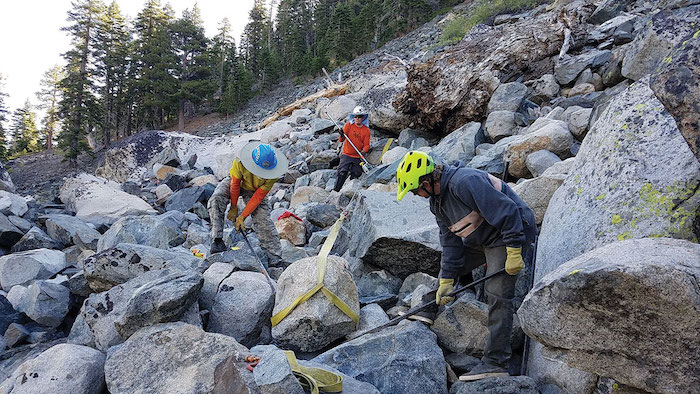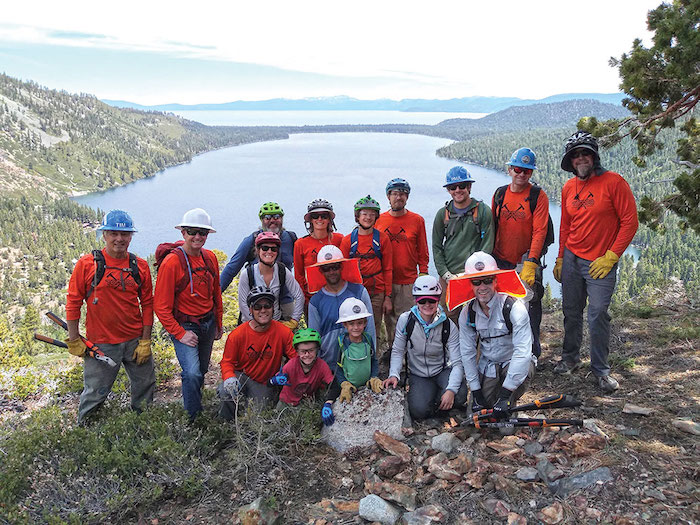
23 Apr Labors of (Singletrack) Love
The trails that crisscross the Tahoe Basin are the result of hard work and thoughtful planning by land managers and dedicated volunteers
Many of us are guilty, at least to some degree, of merrily hiking or biking over ribbons of dirt without recognizing the efforts that went into creating these trails. But to learn the stories behind Tahoe’s beloved trails is to gain a new appreciation for these recreational treasures, as well as the men and women who toil over their existence.
Like portals to the wild, the various paths that crisscross the Tahoe Basin—enabling us to zip through the woods and traverse scenic ridgelines with ease—are true labors of love, executed with thoughtful insight and sheer physical labor, often for zero pay.
“It always strikes me every time I see some group of people doing incredibly hard work and smiling while they are doing it. It is grunt labor, most basic labor, and they are smiling and choose to do it,” says Jacob Quinn, trail program manager for the Forest Service’s Lake Tahoe Basin Management Unit. “It uplifts me.”
Whether trails are built by crews of full-time professionals or volunteers led by experienced crew leaders, the people who spend their days wielding blunt instruments for the enjoyment of others deserve their due credit. After all, without them, Tahoe would not be the recreational playground that it is.

Trail-builders move boulders along the Lily Lake Trail, photo courtesy TAMBA
Grunt Work
Trails in the Tahoe region are primarily built and maintained by Forest Service crews and volunteer organizations such as the Tahoe Rim Trail Association, Truckee Donner Land Trust and Tahoe Area Mountain Biking Association (TAMBA).
The work they perform is far from easy.
Whether breaking ground on a new path or removing the dozens of trees that fell across a trail during the winter, progress is achieved through the backbreaking use of crude implements of steel and wood. Chainsaws are the tool of choice for tree removal, while trail-builders often work with pulaskis and McLeods—two-sided tools combining an axe and an adze and a rake and a pick, respectively.
“You have to have a strong back and a weak mind to be a trail-builder,” jokes Dave Schnake, board president for the Tahoe Rim Trail Association. “To most people it seems crazy to do what we do. ‘You do that and don’t get paid?’ they say.”
But Schnake says he feels deeply satisfied at the end of a day, when he can look at his hard work and see a trail being created where before there was just dirt and rocks. That same sense of fulfillment is what drives the small group of dedicated volunteers who continually donate their time and muscle to building and maintaining trails in the Tahoe area.
Among this group, Schnake has found that a high percentage of the most active trail-builders are military veterans with a penchant for hard work and staying busy—specifically, by manhandling humongous rocks in the scenic Tahoe backcountry.
“They like that focus and getting involved with logistics and planning the workday,” says Schnake, adding that these veterans have no problem putting in a long, hard day. In fact, he says, they pride themselves on it.

From left, Julia Kaseta, Lindsey Schultz and Kristine Koran take a break from their work installing signs on Freel Peak, photos courtesy TRTA
Brains Behind the Builds
While trail-building could not be achieved without hard physical labor, a certain amount of art and science are also required to create a path that is able to withstand the ravages of weather, time and use.

Julia Kaseta and Lindsey Schultz work on a section of the Showers Lake Bowl Trail, photo courtesy TRTA
“The science is in the construction of the trail for water management; the art is to design a certain kind of experience for the user,” says Quinn.
Adds Kevin Starr, stewardship coordinator for the Truckee Donner Land Trust: “There is an artistic side, an empty canvas to design these things. It is very satisfying to put tools to the ground and by the end of the day you are looking at a piece of singletrack that is close to what you envision.”
Well before a pulaski digs into the dirt, however, winters are a time for planning for the trail-building season ahead. The process includes environmental analysis, grant writing and scouting the best route for a given trail.
“You spend days and days laying it out,” says John Clausen, senior crew leader for TAMBA.
Laying out a trail involves looking for the sweet spots that lead people to ideal locations—say, a nice view of the lake—while avoiding places such as meadows, stream crossings or sensitive animal habitats. And the trail creators have to do all that while keeping the grade reasonable and the distance manageable before receiving the green light from land managers to build.
“Sometimes a land manager will suggest the ideas and sometimes you approach them with your ideas,” says Clausen. “If it is a reroute of an existing trail that has erosion problems, they love having a qualified organization come in and address the problem areas. It’s a win-win for everyone.”
Trail-builders also have to deal with the different expectations of users. Trails that are primarily used by mountain bikers are a classic example.
Some riders prefer smooth trail beds while others thrive on challenging, rocky trails. Meanwhile, hikers, bikers, runners, dog walkers and equestrians share the non-motorized trails and are all looking for an experience that is best for them.
“Our general strategy is that every trail is a multi-use or shared trail,” says Quinn. “We do that strategically because we feel like you will never have enough land to build enough trails if the model is that every trail is only for a single use type.”

Trail-builders of the Tahoe Basin are often volunteers who donate their time and effort to the cause, photo by Scott Brown, courtesy TAMBA
Satisfaction Through Trail-building
Trail-builders have many reasons for dedicating their time and effort to the cause.
Some, especially first-timers, do it because they want to give back to the trails they love. Others spend their lives in the city and want to get away from civilization for a day. Or they could be retired people who view trail-building as something beneficial to do with their free time.
But the professionals who do it for a living, and the volunteers who are committed to spending significant time working in the field, do it primarily for the satisfaction of creating something that will be fun for others to use.
“I take a lot of pride in trail-building, especially when someone comes along and said they had so much fun riding on a trail that I worked on,” says Clausen. “Building a trail isn’t brain surgery, but if you can recharge someone and can feel reinvigorated, that makes it worthwhile.
“This (past) summer with the pandemic, we saw how important trails were for everyone.”
Tim Hauserman is a nearly lifelong Tahoe resident and writer who has spent thousands of hours enjoying the handiwork of the master trail-builders in the area. He encourages anyone who does the same to contact a local trail-building organization and spend a day wielding a blunt instrument—so that they, too, can feel profoundly satisfied in creating a few lovely feet of trail that will make someone smile.




No Comments